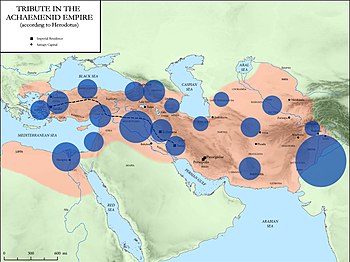Taxation districts of the Achaemenid Empire

Herodotus divided the Achaemenid Empire into 20 districts for the purpose of tribute payments. The following is a description of the ethnic makeup of the districts and the amount they paid in taxes, translated from Herodotus' Histories.[1][2]
Accounting units
The quantities of silver are given in Babylonian talent (1 Babylonian talent = about 30.3 kg), while the quantities of gold (India only) are given in Euboïc/Euboean talent (1 Euboïc talent = about 26 kg).[2][1] Only the Hindush paid in gold, the exchange rate of gold to silver being 1 to 13 by weight at the time of Herodotus.[2][1]
Tax districts
The order of the districts given here follows Herodotus, Histories, III.90–94. In hellenocentric way it starts with Ionia and Mysia. The official Persian order of the provinces, as devised under Darius I in 518 BCE, was different and started from the Empire's capital: 1. Media, 2. Susa, etc.[4] For comparison, it is given in the rightmost column.
| District | Satrapies | Tribute per District | % of total | Darius's provinces |
|---|---|---|---|---|
| I | Ionians, Asian Magnesians, Aeolians, Carians, Lycians, Milyans, Pamphylians | 400 Babylonian talents of silver | 3.6% | 10. Ionia |
| II | Mysians, Lydians, Lasonians, Cabalians, Hytennians | 500 Babylonian talents of silver | 4.5% | 9. Lydia |
| III | Hellespontine Phrygians, Phrygians, Asian Thracians, Paphlagonians, Mariandynians, Syrians | 360 Babylonian talents of silver | 3.2% | 8. Cappadocia |
| IV | Cilicians | 500 Babylonian talents of silver along with 360 white horses (one for each day of the year); of the talents, 140 were used to maintain the cavalry force that guarded Cilicia | 4.5% | 11. "Sealand" (Cilicia and Cyprus) |
| V | The area from the town of Posidium as far as Egypt, omitting Arabian territory (which did not pay taxes). All of Palestine, Cyprus, and most of Phoenicia were herein contained. In the biblical Book of Ezra, this district is called Abar Nahara ("beyond the Euphrates river") | 350 Babylonian talents of silver | 3.1% | 4. Assyria, 5. Arabia |
| VI | Egyptians and the Libyans in the border towns of Cyrene and Barca | 700 Babylonian talents of silver, in addition to the money from the fish in Lake Moeris, and 120,000 bushels of grain for the Persian troops and their auxiliaries stationed in the White Castle at Memphis | 6.3% | 6. Egypt |
| VII | Sattagydians, Gandharans, Dadicae, Aparytae (Indian Satrapies) | 170 Babylonian talents of silver | 1.5% | 19. Gandhara |
| VIII | Susa and the surrounding area, Cissia | 300 Babylonian talents of silver | 2.7% | 2. Susiane |
| IX | Mesopotamia (Babylonia and Assyria) | 1000 Babylonian talents of silver and 500 eunuch boys | 9% | 3. Mesopotamia |
| X | Ecbatana and the rest of Media along with the Paricanians and Orthocorybantians | 450 Babylonian talents of silver | 4% | 1. Media |
| XI | Caspians, Pausicae, Pantimathi, and Daritae | a joint sum of 200 Babylonian talents of silver | 1.8% | |
| XII | Bactrians and all neighboring peoples as far as the Aegli | 360 Babylonian talents of silver | 3.2% | 15. Bactria |
| XIII | Pactyica, Armenians, and all the peoples as far as the Black Sea | 400 Babylonian talents of silver | 3.6% | 7. Armenia |
| XIV | Sagartians, Sarangians, Thamanaeans, Utians, Myci, and the inhabitants of the Persian Gulf islands (where prisoners or displaced people were sent) | together they paid 600 Babylonian talents | 3.6% | 12. Sagartia |
| XV | the Sacae and the Caspians | 250 Babylonian talents of silver | 2.2% | |
| XVI | Parthians, Chorasmians, Sogdians, and Arians | 300 Babylonian talents of silver | 2.7% | 13. Parthia, 14. Aria, 16. Sogdiane |
| XVII | Paricanians and Asiatic Ethiopians | 400 Babylonian talents of silver | 3.6% | 20. Maka |
| XVIII | the Matienians, Saspires, Alarodians | 200 Babylonian talents of silver | 1.8% | |
| XIX | the Mushki, Tibareni, Macrones, Mossynoeci, Marres | 300 Babylonian talents of silver | 2.7% | |
| XX | India | 360 Euboïc talents of gold dust, equivalent to 4680 Euboïc talents of silver, or 3600 Babylonian talents of silver.[1][2] | 32% | 17. Arachosia, 18. India |
| Total | Total of all annual tributes, in Babylonian talent silver equivalent | 11,200 Babylonian talents of silver, equivalent to 14,560 Euboïc talents of silver | 100% |
See also
Citations
- ^ a b c d e Herodotus Book III, 89-95
- ^ a b c d e Archibald, Zosia; Davies, John K.; Gabrielsen, Vincent (2011). The Economies of Hellenistic Societies, Third to First Centuries BC. Oxford University Press. p. 404. ISBN 9780199587926.
- ^ "INDIA RELATIONS: ACHAEMENID PERIOD – Encyclopaedia Iranica". www.iranicaonline.org.
- ^ Hermann Bengtson, Vladimir Milojčić (ed.), Grosser Historischer Weltatlas, Erster Teil: Vorgeschichte und Altertum (München, Bayerischer Schulbuch-Verlag, 4th ed., 1963), p. 11, Map (b), "Reich der Meder und Perser".


